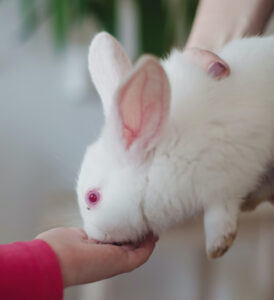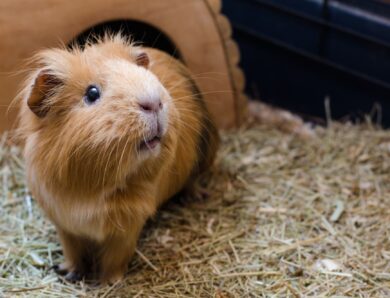
Best Pet Rabbit Breeds for First-Time Owners
If you’ve never owned a rabbit before, you might expect that all rabbits are the same. You’d be wrong. Like dogs and cats, rabbits come in a variety of breeds and their temperaments can differ drastically. Not all breeds can be generalized, but there are some pet rabbit breeds you can depend on to be friendly and active.
However, just because some breeds are known for being sociable, doesn’t mean you can’t find outgoing, laid-back bunnies in other breeds. In general, when you’re meeting perspective rabbits for the first time, you want to watch out for a few things.
Does the rabbit come to the edge of her pen right away, curious to meet you? Once you’ve let the bunny out to hop around, does he approach you? Does she let you pet her?
Chances are a rabbit that cowers in its pen when you try to pet it will take a long time to warm up, and may never be a bunny you can play with.
Generally speaking, rabbits are social and first-time rabbit owners should be prepared to spend lots of time with them every day. And, the most well-adjusted are those given lots of time to roam around and played with on a regular basis. If you just want a pet you can leave in its cage and play with maybe 30 minutes a day, a rabbit is probably not the best choice for you.
Ready to find your first bunny? We spoke to Elizabeth Krieger, the adoption coordinator at the Great Lakes Rabbit Sanctuary to get some tips on which pet rabbit breeds are best, where you should go to get your bunny, and what to avoid.
Skip the Pet Store
As with dogs and cats, pet stores stock their rabbits from bunny mills, where conditions aren’t good and the breeding rabbits lead terrible lives.
If you’re looking to add a bunny to your family, skip the pet store and head to a local rabbit rescue or find a reputable breeder.
Learn which 7 surprising foods you shouldn’t feed your bunny.
Benefits of Adopting a Rabbit
A main benefit of adopting is that staff can usually pair adopters with the perfect bunny for their needs. Unless a rabbit has only been on site for a short amount of time, staff get to know each rabbit’s personality well enough to make recommendations.
Most rescue rabbits are adults, which Krieger says makes them great for first-time rabbit owners.
While baby bunnies are adorable, their true personalities don’t typically emerge until after they’ve been spayed or neutered (3 to 4 months for males/5 to 6 months for females).
“When they’re younger, they are almost always curious about everything. They don’t care if you’re picking them up. They don’t care if you pet them,” Krieger says.
But this friendly, laid-back attitude doesn’t always last, she adds. There can be quite a difference in personality between youth and adulthood.
Which breed of rabbit is most friendly?
Though adult rabbits aren’t always as friendly as their younger selves, certain pet rabbit breeds are known for their affectionate nature.
Krieger’s top recommendations for best pet rabbit breeds are polar opposites in terms of appearance.
The Dutch rabbit, which is about 4 to 5 pounds full-grown, is energetic and loves to be out and about. Its temperament is friendly and easy-going. One of the most popular pet rabbit breeds, the Dutch rabbit is perfect for families with children.
On the opposite end of the size spectrum is the Flemish giant, which can weigh up to 22 pounds. (The average is 15 pounds.) Flemish giants are generally docile, enjoy being handled, and are social by nature.
Whenever the Great Lakes Rabbit Sanctuary gets a Flemish giant, it’s snapped up faster than they can get it on PetFinder.com.
And they’re not the only big breed that is good for first-time rabbit owners, though first-timers don’t often consider them.
“I think people are intimidated by the bigger breeds because they’re not what everyone imagines a little pet rabbit should be,” Krieger says. But in general, the bigger the rabbit breed, the more chill and easier going they are.
First-time rabbit owners interested in a Flemish giant should be prepared for the amount of space they need, and the cost of feeding them. Flemish giants do better when they can be active, resulting in a need for plenty of room to move around.
Large dog crates are more appropriate for these large rabbits than traditional rabbit cages. You can even use a small room — if you have an extra one — rather than a crate or cage.
And like big dogs, the large rabbit breeds often have shorter lifespans than their medium-sized cousins.
Lops
A third rabbit that Krieger recommends for first-time bunny owners is the Holland lop. (There are several varieties of lops, all characterized by droopy ears.)
Weighing between 3 and 5 pounds, Holland lops are technically dwarf rabbits and are among the cutest rabbit breeds. Krieger describes Holland lops as “really easy going and really cute.”
Holland lops can, however, have health problems. Like pugs, they have squished faces and, as a result, can suffer from respiratory illnesses. They’re also prone to teeth issues. Not all Holland lops will have a problem. But as a breed, in general, they need more vet care than breeds without squished faces.
Another lop Krieger recommends is the Mini lop, which despite its name is larger than the Holland lop, weighing about 4.5 to 6 pounds. They have easy-going temperaments, are social and enjoy being handled.
Avoid These Types of Rabbits for Pets
Dwarf rabbits are extremely cute and very popular. Consequently, they’re one of the most common types of pet rabbits you’ll find for sale in pet stores.
Because of their size — about 2.5 to 3 pounds — dwarf rabbits are marketed as great pets for kids.
As it turns out, Krieger says, they’re anything but.
Dwarf breeds are generally more nervous and high-strung. They do not particularly enjoy being held and petted — not something most kids will appreciate. (The exception to this is the Holland lop, which is sturdier in build, friendly, and sociable.)
“Often when we get them in the shelter, they’re owner surrender because [people] weren’t expecting them to be so hard to manage,” Krieger says.
Equally as important is how easily dwarf breeds can get hurt. In general, rabbits are fairly fragile. The smaller they are, the easier it is for injuries to happen. And with young kids in the house, accidents are more likely.
Homes with older kids and teenagers can be safer for dwarf rabbits; the older the kid, the less likely they are to accidentally injure the rabbit. If your heart is set on a dwarf rabbit, Krieger suggests adopting through a rescue group so you can be paired with a friendly one.
White, Red-Eyed Rabbits

Californian whites and other white, red-eyed rabbits are the spitting image of the Easter Bunny. Yet, they are the most commonly abandoned. And not because they’re unfriendly or difficult to handle; Californian rabbits are quite social and friendly.
Most people purchase Californians in pet stores as little babies, but they are not small rabbits. They grow to between 7 and 10 pounds, often catching people unprepared for their larger size.
But even more damming than their size, Krieger says, their red eyes are what drive most people to abandon them.
“People just don’t like the red eyes,” she says. “They find it creepy. I’ve heard that from a lot of people.”
Regardless of breed, the rabbits that stay at the Great Lakes Rabbit Sanctuary longest are always white with red eyes.
If you’re not creeped out by red eyes, Californians are great rabbits for first-time owners with kids. Their bigger size makes them less fragile, and, as already mentioned, they’re friendly.
1 Comment
Comments are closed.






I learned a lot about different rabbits.